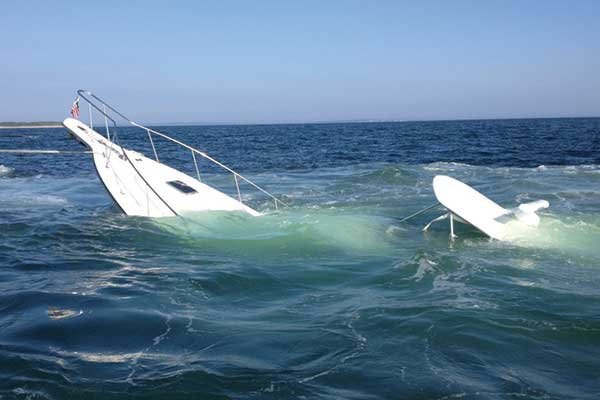New Boating Safety Law For 2021
As we enter the new Put-in-Bay 2021 boating safety season, A New Law (That Put-in-Bay mariners should be aware of) in now in effect.
The Basics: WASHINGTON — Operators of recreational vessels less than 26 feet in length will be required to use an engine cut-off switch (ECOS) and associated ECOS link (ECOSL) as of April 1, 2021, as the U.S. Coast Guard implements a law passed by Congress. Section 503 of the Coast Guard Authorization Act of 2018 required manufacturers of covered recreational vessels (less than 26 feet in length, with an engine capable of 115 lbs. or more
of static thrust) to equip the vessel with an ECOS installed as of December 2019.
New Law Expected to enhance Boating Safety
Owners of recreational vessels produced after December 2019 are required to maintain the ECOS on their vessel in a serviceable condition. It is recommended that recreational vessel owners regularly check their existing ECOS system to ensure it works properly, following the manufacturer’s
instructions.
Section 8316 of the Elijah E. Cummings Coast Guard Authorization Act of 2020 requires individuals operating covered recreational vessels (less than 26 feet in length, with an engine capable of 115 lbs. or more of static thrust, which equates to about 3 horsepower or more) to use ECOS “links” while operating on plane or above displacement speed.
Using the ECOSL is not required when the main helm is installed within an enclosed cabin. Common situations where ECOSL use would not be required include docking/trailering, trolling, and operating in no-wake zones. Here’s The Skinny on the new boating safety law: An Engine Cut-Off Switch is a safety mechanism used to shut off propulsion machinery when the operator is displaced from the helm. An ECOSL is the device that connects the operator to
the ECOS.
The link must be attached to the operator, the operator’s clothing, or the operator’s personal floatation device. It is typically a coiled lanyard, but may also be an electronic fob. All operators of recreational boats less than 26’ in length that have an Engine Cut-Off Device installed are required to use it.
What Boats Need to Have an Engine Cut-Off Switch Installed for Boating Safety?
Boats less than 26 feet in length generating more than 115 lbs. of static thrust (~3hp) and were built beginning in January 2020. If the boats’ primary helm is inside an enclosed cabin it is not required to have an Engine Cut-Off Switch. If your boat was built before January 2020, but has an ECOS installed, you now must use it in accordance with the above regulation(s).
New Boaters in Island Waters!
The Pandemic has brought about a record surge in new boat sales in our area. One of the reasons has been people looking for Covid safe activities for their families. This record surge will produce additional challenges for Put-in-Bay Boating in our sometimes overcrowded waterways and marinas. Several area dealers have expressed concerns that many new boaters will be getting behind the helm of a new vessel without having any boater education
whatsoever.
Put-in-Bay boaters visiting Lake Eries Hidden Vacation destinations will need to stay sharp with heightened situational awareness. Despite this development, I am convinced that we can still have a fun and safe boating season in the Erie archipelago if we are a little more cognizant of the boaters around us at all times.
Put-in-Bay Vessel Boating Safety Check Time Is Here!
Finally, it’s that time of year again…Boating Season! After one long hard Winter (for those of us who didn’t head south), it’s time to get things thawed out and shipshape. One of the keys to safe boating is making sure that your vessel is seaworthy and compliant with current boating laws governing the Great Lakes (where I presume that most of us do our boating). I strongly urge that you have a vessel exam (called a Vessel Safety Check or VSC) performed by the USCGAUX before you head out onto the water this season to enjoy visiting Put-in-Bay Ohio.
Not A Law Enforcement Action A Boating Safety Suggestion
Vessel Safety Checks performed by the Coast Guard Auxiliary ARE NOT a law enforcement action and you WILL NOT be cited if your vessel should happen to fail. Rather, these courtesy checks give you an opportunity to correct any issues or violations in advance of being stopped and perhaps fined by the Coast Guard while you are underway. If you do pass our safety check, you will receive a window decal to be affixed to your vessel alerting the Coast Guard that
you have been inspected and perhaps averting a boarding.
Put-in-Bay Residents Can Call Me
I am officially back on the Island from now through October and I’m available to personally inspect your vessel free of charge. The best way to reach me is via email: paulbolden.uscgaux@gmail.com. You can also call me at 614-848-4544 ext. 4. State that you’re at Put-in-Bay and would like to have a Vessel Safety Check to promote boating safety.
How To Pass A Vessel Inspection (VSC) – Part 1 Of 3
In this three-part series, we are going to cover everything needed for Put-in-Bay residents to pass a Vessel Safety Check (VSC). By understanding the examination requirements in advance, it is much more likely that your boat (or jet ski, etc) will pass the inspection which will also make the job a lot easier on the vessel examiner. Let’s get started
1) Registration. Make sure that the correct vessel registration is on board and is current. In addition to a valid date, the vessel’s state registration
numbers, and hull identification number must match the registration document exactly. FOR DOCUMENTED VESSELS: Documentation numbers must be permanently marked on a visible part of the interior structure.
The documented boat’s name and hailing port must be displayed on the exterior hull in letters not less than 4 inches in height. You would be surprised at the number of people that I’ve encountered who can’t produce their boat registration or not even sure which document it is. Not producing the correct documentation has us off to a bad start and it’s usually downhill from there. PLEASE have your correct documentation on board.
2) Display of Numbers. This is the number one violation that I see around Put-in-Bay. Numbers must be permanently attached to each side of the forward
half of the vessel. The numbers must be read from left to right, and of a color contrasting with the background color; for example, black numbers
on a white hull. Lettering must be in plain, vertical block characters of not less than 3 inches in height. Spaces or hyphens between letter and number
groupings must be equal to the width of a letter other than “I” or a number other than “1”. The validation stickers must be affixed within six inches of
the registration numbers.
NOTE: The letters/numbers should be a plain block font like “Ariel” not cursive, swirly, or otherwise. The letters/numbers should not be multiple colors, fancy fadings, shadows, or outlines. Caution: Even though local stores are willing to sell you these types of lettering, it does not make it legal to display on your vessel.
3) Personal Flotation Devices. The USCG requires that there be a USCG-approved PFD (in good condition) onboard for each passenger. Vessels 16’ – 65’ must also carry a Type IV throwable device such as a cushion or ring buoy. Children must have a PFD suitable for their size. In Ohio, children under the age of 10 must be wearing their PFD while onboard vessels 18’ or less.
4) Visual Distress Signals. Here are the basics. For vessels less than 16’ distress signals are only required when operating between sunset and sunrise.
3 combination day/night red flares or 1 electric distress light is required. For vessels 16’ or longer, you are required to have 3 handheld or floating orange
smoke signals and 3-night flares or 3 combination day/night flares, hand-held, meteor or parachute type or 1 orange distress flag and 1 electric distress light or 3 handheld or floating orange smoke signals and one electric distress light or flare gun with 3 days/night cartridges.
NOTE: Make sure that your flares are not expired. There are other combinations possible. If you have any questions, contact the USCG-AUX at 419-379-9000.
5) Fire Extinguishers. Fire extinguishers are required if one of the following conditions exists: (1) Inboard engine(s); (2) Closed compartments that store portable fuel tanks; (3) Double bottom hulls not completely sealed or not completely filled with flotation materials (4) Closed living space (5) Closed
stowage compartments that contain flammable materials or (6) Permanently installed fuel tanks.
Power vessels <26’ or are required to have 1 B-I fire extinguisher. Power vessels 26’ to <40 are required to have 2 B-1 or 1 B-2 extinguisher. Power
vessels 40’ to 65’ must have 3 B-1 or 1 B-1 and 1 B-2 extinguisher. The fire extinguisher gauge should be green, and the unit should not be
more than 10 years old. A 2 digit date is often stamped on the bottom of the extinguisher. A fixed system such as “Halon” replaces 1 B-1 extinguisher. Ensure that your fixed system’s maintenance requirements are current and that the proper maintenance certificate is properly affixed.
6) Ventilation. Boats with gasoline engines in closed compartments, built after 1 August 1980, must have a powered ventilation system. Those built before that date must have natural or powered ventilation. The ventilation system is designed to remove potentially dangerous fumes. Usually, to the aft starboard and port are the intake and exhaust vents. Turn on your exhaust and place your hand over the exhaust port and make sure that it is blowing air out.
ADDITIONALLY: Boats with closed fuel tank compartments built after 1 August 1978 must meet requirements by displaying a “certificate of compliance.” Boats built before that date must have either natural or powered ventilation in the fuel tank compartment. Outboard-equipped vessels are exempt.
7) Backfire Flame Control. Called a Flame Arrestor needs to be clean and oil-free. HINT: The arrestor is situated on top of the carburetor and held in place by a single nut. Outboard and Diesel engines are exempt.
8) Sound Producing Device. This one is simple. All vessels to 65’ are required to have a sounding device such as an installed boat horn, whistle or air horn, etc., capable of a 4-second blast audible for ½ mile. Vessels 65’ feet or more in length are required to carry a whistle or horn and a bell that are audible for
1 mile.
9) Navigation Lights. All boats must display navigation lights between sunset and sunrise and in conditions of reduced visibility. Boats 16 feet or more in length must have properly installed, working navigation lights, and an all-around anchor light capable of being lit independently from the red/green/ white “running” lights.
Next Month
Next month, part two of this Boating Safety series will cover Pollution Placards, Marpol Placards, Navigation Rules, State and Local requirements, and overall vessel condition. Let’s make this boating season on the waters around Put-in-Bay safe and accident-free. You can read about the ultimate guide to visiting Put-in-Bay here


Leave A Comment